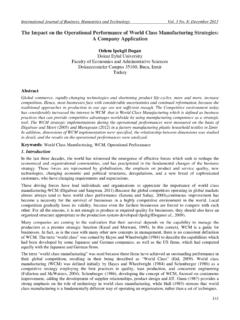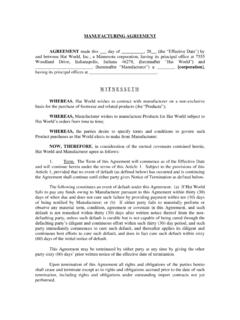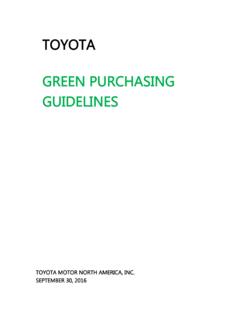Transcription of WHO guidelines on - World Health Organization
1 WHO guidelines on good manufacturing practices (GMP) for herbal medicines Contents Contents Acknowledgements ..v Preface ..vii Section I ..1. WHO good manufacturing practices (GMP): updated supplementary guidelines for the manufacture of herbal medicines Section II ..21. WHO good manufacturing practices (GMP): main principles for pharmaceutical products Annex 1 ..67. List of participants of WHO Consultation on Quality Control of Herbal Medicines, Abu Dhabi, United Arab Emirates, 13 15 June 2005. Annex 2 ..71. Table of contents of Quality assurance of pharmaceuticals: a compendium of guidelines and related materials, Vol.
2 2, 2nd updated edition, Good manufacturing practices and inspection WHO guidelines on good manufacturing practices (GMP) for herbal medicines Acknowledgements Acknowledgements The World Health Organization wishes to express its gratitude for the generous support provided by the Nippon Foundation for printing these guidelines as one publication. WHO thanks Health Canada, especially the Natural Health Products Directorate, which hosted and supported the WHO Working Group Meeting on quality control of herbal medicines, held in Vancouver, Canada, in February 2004.
3 Thanks are also due to the General Authority for Health Services for the Emirate of Abu Dhabi, who hosted the WHO Consultation on quality control of herbal medicines, Abu Dhabi, United Arab Emirates, in July 2005, in collaboration with the Ministry of Health of the Government of United Arab Emirates, and the logistic support of the Zayed Complex of Herbal Research and Traditional Medicine, Abu Dhabi, now a WHO Collaborating Centre for Traditional Medicine. WHO also acknowledges its indebtedness to the more than 250 reviewers, including members of the WHO Advisory Expert Panel on Traditional Medicine and on Pharmaceutical Specifications, WHO Collaborating Centres for Traditional Medicine, and national authorities, in over 105 countries who provided comments and advice on the draft texts of the updated supplementary guidelines for the manufacture of herbal medicines.
4 Preparation of these guidelines also benefited from the technical support received from relevant United Nations agencies, international organizations and nongovernmental organizations. Special thanks are due to the participants at the WHO Consultation on Quality Control of Herbal Medicines, held in Abu Dhabi, United Arab Emirates in July 2005 to review the draft guidelines (see Annex 1) and to experts who attended the working group meeting held in Vancouver, Canada, in February 2004. WHO also thanks the WHO Expert Committee on Specifications for Pharmaceutical Preparations, who met in 2004, 2005 and 2006, for their review of, technical guidance on, and adoption of the supplementary guidelines .
5 Acknowledgement of his work in preparing the original text of the updated supplementary guidelines is also due to Professor Tamas Paal, Hungary. v WHO guidelines on good manufacturing practices (GMP) for herbal medicines vi Preface Preface With the constant increase in the use of herbal medicines worldwide and the rapid expansion of the global market, the safety and quality of herbal materials and finished herbal products have become a major concern for Health authorities, pharmaceutical industries and the public.
6 The safety and efficacy of herbal medicines largely depend on their quality. Requirements and methods for quality control of finished herbal products, particularly for combining/mixing herbal products, are far more complex than for chemical drugs. The quality of finished herbal products is also influenced by the quality of the raw materials used. The latest World Health Assembly resolution on traditional medicine ( ) requested WHO to provide technical support to develop methodology to monitor or ensure the quality, efficacy and safety of products.
7 The quality of herbal medicines can directly affect their safety and efficacy. Member States face complicated technical issues in the quality control of herbal medicines. In order to promote and improve the quality of herbal medicines and also to reduce the proportion of adverse events attributable to the poor quality of herbal medicines, WHO has committed to the development of a series of technical guidelines related to quality assurance and control of herbal medicines, as well as to updating existing guidelines .
8 The manufacturing process is one of the key steps where quality control is required to ensure quality of medicinal products, including herbal medicines. Good manufacturing practices (GMP) is one of the most important tools for this measure. The core requirements for GMP for herbal medicines are common to GMP for pharmaceutical products. In 1996, WHO issued "Good manufacturing practices: supplementary guidelines for the manufacture of herbal medicinal products".1. However, at that time, not many Member States were considering GMP.
9 Requirements for herbal medicines, and only key technical issues were presented. The increasing use of herbal medicines has led to further research on them and to the development of techniques for their quality control. In addition, more and more Member States have started to establish their own national GMP specific for herbal medicines. Therefore it became desirable for WHO to update the Good manufacturing Practices (GMP) supplementary guidelines for manufacture of herbal medicines. These updated guidelines were finalized in 2005 and adopted by a WHO Expert Committee in 2006, leading to publication as annex 3 of WHO.
10 Technical Report Series, No. 937 (2006). In addition, WHO has also updated its core guidelines on GMP, which were published as annex 4 of WHO Technical Report Series, No. 908 (2003). As a whole, GMP control for herbal medicines needs to meet the technical requirements of both sets of guidelines . In order to 1 WHO Technical Report Series, No. 863, 1996. vii WHO guidelines on good manufacturing practices (GMP) for herbal medicines consolidate the information and to make such technical guidance user-friendly, it was proposed to compile a WHO monograph on GMP for herbal medicines, which combines these two sets of technical guidelines .















